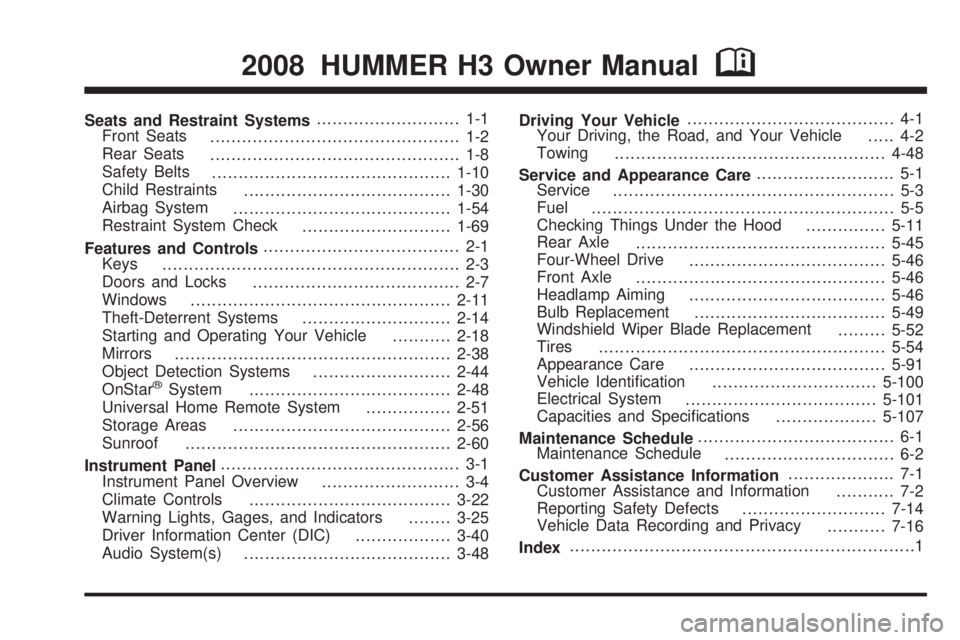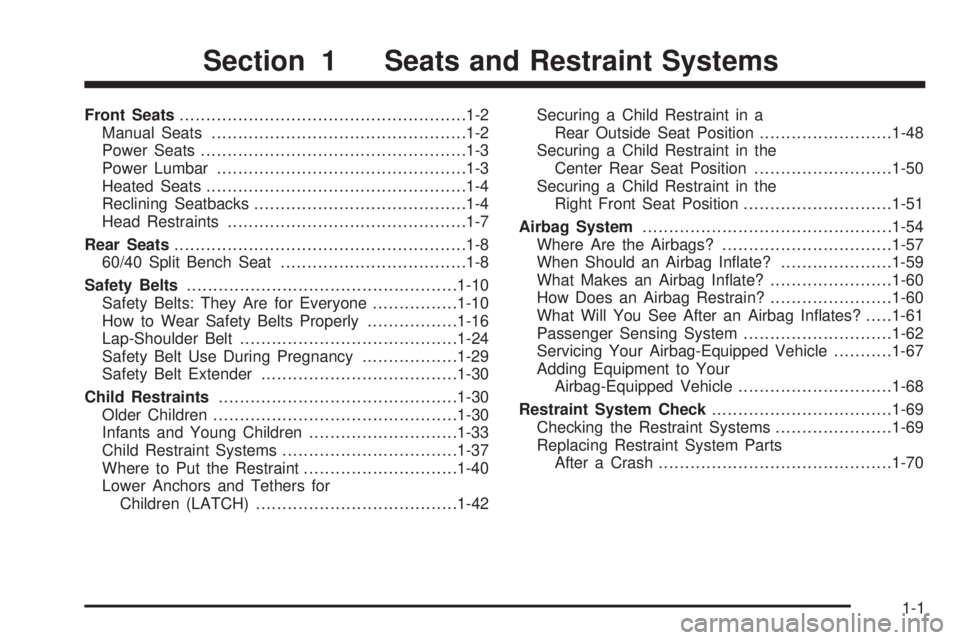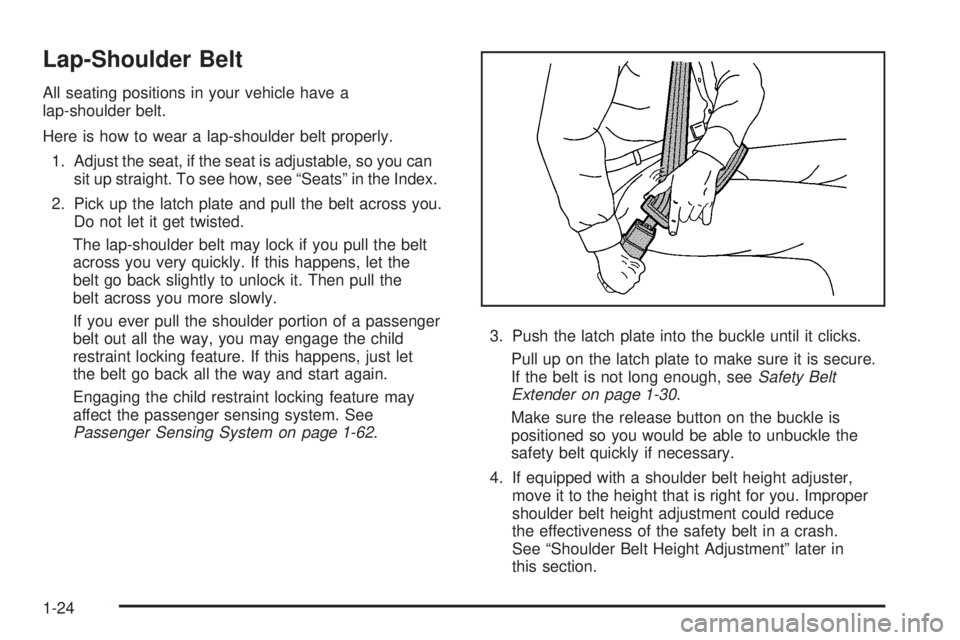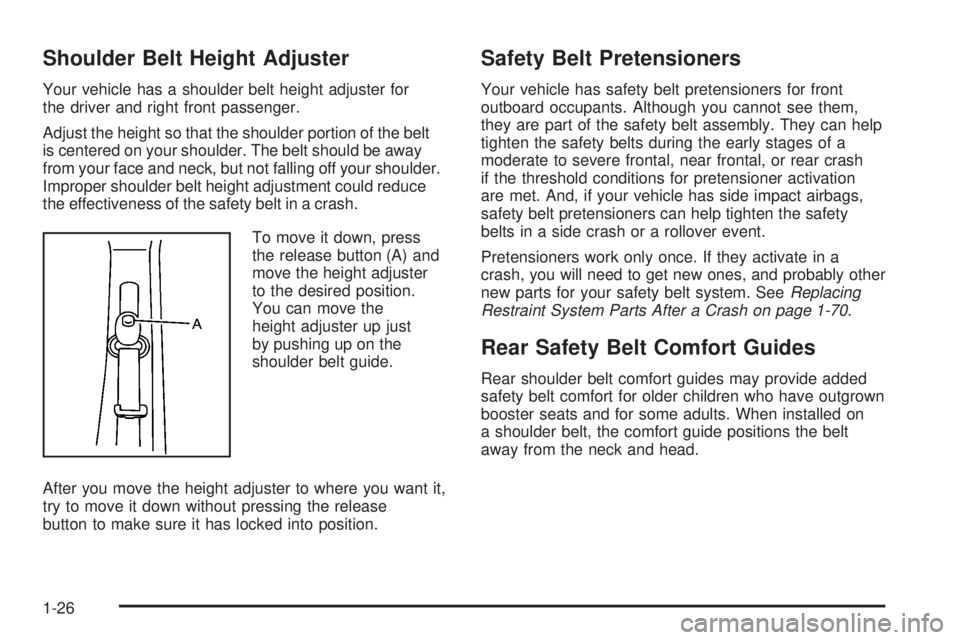child seat HUMMER H3 2008 Owners Manual
[x] Cancel search | Manufacturer: HUMMER, Model Year: 2008, Model line: H3, Model: HUMMER H3 2008Pages: 416, PDF Size: 5.66 MB
Page 1 of 416

Seats and Restraint Systems........................... 1-1
Front Seats
............................................... 1-2
Rear Seats
............................................... 1-8
Safety Belts
.............................................1-10
Child Restraints
.......................................1-30
Airbag System
.........................................1-54
Restraint System Check
............................1-69
Features and Controls..................................... 2-1
Keys
........................................................ 2-3
Doors and Locks
....................................... 2-7
Windows
.................................................2-11
Theft-Deterrent Systems
............................2-14
Starting and Operating Your Vehicle
...........2-18
Mirrors
....................................................2-38
Object Detection Systems
..........................2-44
OnStar
®System
......................................2-48
Universal Home Remote System
................2-51
Storage Areas
.........................................2-56
Sunroof
..................................................2-60
Instrument Panel............................................. 3-1
Instrument Panel Overview
.......................... 3-4
Climate Controls
......................................3-22
Warning Lights, Gages, and Indicators
........3-25
Driver Information Center (DIC)
..................3-40
Audio System(s)
.......................................3-48Driving Your Vehicle....................................... 4-1
Your Driving, the Road, and Your Vehicle
..... 4-2
Towing
...................................................4-48
Service and Appearance Care.......................... 5-1
Service
..................................................... 5-3
Fuel
......................................................... 5-5
Checking Things Under the Hood
...............5-11
Rear Axle
...............................................5-45
Four-Wheel Drive
.....................................5-46
Front Axle
...............................................5-46
Headlamp Aiming
.....................................5-46
Bulb Replacement
....................................5-49
Windshield Wiper Blade Replacement
.........5-52
Tires
......................................................5-54
Appearance Care
.....................................5-91
Vehicle Identi�cation
...............................5-100
Electrical System
....................................5-101
Capacities and Speci�cations
...................5-107
Maintenance Schedule..................................... 6-1
Maintenance Schedule
................................ 6-2
Customer Assistance Information.................... 7-1
Customer Assistance and Information
........... 7-2
Reporting Safety Defects
...........................7-14
Vehicle Data Recording and Privacy
...........7-16
Index.................................................................1
2008 HUMMER H3 Owner ManualM
Page 5 of 416

Front Seats......................................................1-2
Manual Seats................................................1-2
Power Seats..................................................1-3
Power Lumbar...............................................1-3
Heated Seats.................................................1-4
Reclining Seatbacks........................................1-4
Head Restraints.............................................1-7
Rear Seats.......................................................1-8
60/40 Split Bench Seat...................................1-8
Safety Belts...................................................1-10
Safety Belts: They Are for Everyone................1-10
How to Wear Safety Belts Properly.................1-16
Lap-Shoulder Belt.........................................1-24
Safety Belt Use During Pregnancy..................1-29
Safety Belt Extender.....................................1-30
Child Restraints.............................................1-30
Older Children..............................................1-30
Infants and Young Children............................1-33
Child Restraint Systems.................................1-37
Where to Put the Restraint.............................1-40
Lower Anchors and Tethers for
Children (LATCH)......................................1-42Securing a Child Restraint in a
Rear Outside Seat Position.........................1-48
Securing a Child Restraint in the
Center Rear Seat Position..........................1-50
Securing a Child Restraint in the
Right Front Seat Position............................1-51
Airbag System...............................................1-54
Where Are the Airbags?................................1-57
When Should an Airbag In�ate?.....................1-59
What Makes an Airbag In�ate?.......................1-60
How Does an Airbag Restrain?.......................1-60
What Will You See After an Airbag In�ates?.....1-61
Passenger Sensing System............................1-62
Servicing Your Airbag-Equipped Vehicle...........1-67
Adding Equipment to Your
Airbag-Equipped Vehicle.............................1-68
Restraint System Check..................................1-69
Checking the Restraint Systems......................1-69
Replacing Restraint System Parts
After a Crash............................................1-70
Section 1 Seats and Restraint Systems
1-1
Page 28 of 416

Lap-Shoulder Belt
All seating positions in your vehicle have a
lap-shoulder belt.
Here is how to wear a lap-shoulder belt properly.
1. Adjust the seat, if the seat is adjustable, so you can
sit up straight. To see how, see “Seats” in the Index.
2. Pick up the latch plate and pull the belt across you.
Do not let it get twisted.
The lap-shoulder belt may lock if you pull the belt
across you very quickly. If this happens, let the
belt go back slightly to unlock it. Then pull the
belt across you more slowly.
If you ever pull the shoulder portion of a passenger
belt out all the way, you may engage the child
restraint locking feature. If this happens, just let
the belt go back all the way and start again.
Engaging the child restraint locking feature may
affect the passenger sensing system. See
Passenger Sensing System on page 1-62.3. Push the latch plate into the buckle until it clicks.
Pull up on the latch plate to make sure it is secure.
If the belt is not long enough, seeSafety Belt
Extender on page 1-30.
Make sure the release button on the buckle is
positioned so you would be able to unbuckle the
safety belt quickly if necessary.
4. If equipped with a shoulder belt height adjuster,
move it to the height that is right for you. Improper
shoulder belt height adjustment could reduce
the effectiveness of the safety belt in a crash.
See “Shoulder Belt Height Adjustment” later in
this section.
1-24
Page 30 of 416

Shoulder Belt Height Adjuster
Your vehicle has a shoulder belt height adjuster for
the driver and right front passenger.
Adjust the height so that the shoulder portion of the belt
is centered on your shoulder. The belt should be away
from your face and neck, but not falling off your shoulder.
Improper shoulder belt height adjustment could reduce
the effectiveness of the safety belt in a crash.
To move it down, press
the release button (A) and
move the height adjuster
to the desired position.
You can move the
height adjuster up just
by pushing up on the
shoulder belt guide.
After you move the height adjuster to where you want it,
try to move it down without pressing the release
button to make sure it has locked into position.
Safety Belt Pretensioners
Your vehicle has safety belt pretensioners for front
outboard occupants. Although you cannot see them,
they are part of the safety belt assembly. They can help
tighten the safety belts during the early stages of a
moderate to severe frontal, near frontal, or rear crash
if the threshold conditions for pretensioner activation
are met. And, if your vehicle has side impact airbags,
safety belt pretensioners can help tighten the safety
belts in a side crash or a rollover event.
Pretensioners work only once. If they activate in a
crash, you will need to get new ones, and probably other
new parts for your safety belt system. SeeReplacing
Restraint System Parts After a Crash on page 1-70.
Rear Safety Belt Comfort Guides
Rear shoulder belt comfort guides may provide added
safety belt comfort for older children who have outgrown
booster seats and for some adults. When installed on
a shoulder belt, the comfort guide positions the belt
away from the neck and head.
1-26
Page 34 of 416

Safety Belt Extender
If the vehicle’s safety belt will fasten around you,
you should use it.
But if a safety belt is not long enough, your
dealer/retailer will order you an extender. When
you go in to order it, take the heaviest coat you will
wear, so the extender will be long enough for you.
To help avoid personal injury, do not let someone else
use it, and use it only for the seat it is made to �t.
The extender has been designed for adults. Never
use it for securing child seats. To wear it, attach it
to the regular safety belt. For more information,
see the instruction sheet that comes with the extender.
Child Restraints
Older Children
Older children who have outgrown booster seats should
wear the vehicle’s safety belts.
1-30
Page 35 of 416

The manufacturer’s instructions that come with the
booster seat, state the weight and height limitations for
that booster. Use a booster seat with a lap-shoulder
belt until the child passes the below �t test:
Sit all the way back on the seat. Do the knees
bend at the seat edge? If yes, continue. If no,
return to the booster seat.
Buckle the lap-shoulder belt. Does the shoulder
belt rest on the shoulder? If yes, continue.
If no, try using the rear safety belt comfort guide.
See “Rear Safety Belt Comfort Guides” under
Lap-Shoulder Belt on page 1-24for more
information. If the shoulder belt still does not rest
on the shoulder, then return to the booster seat.
Does the lap belt �t low and snug on the hips,
touching the thighs? If yes, continue. If no,
return to the booster seat.
Can proper safety belt �t be maintained for
the length of the trip? If yes, continue. If no,
return to the booster seat.
Q:What is the proper way to wear safety belts?
A:An older child should wear a lap-shoulder belt and
get the additional restraint a shoulder belt can
provide. The shoulder belt should not cross the
face or neck. The lap belt should �t snugly
below the hips, just touching the top of the thighs.
This applies belt force to the child’s pelvic bones
in a crash. It should never be worn over the
abdomen, which could cause severe or even
fatal internal injuries in a crash.
Also see “Rear Safety Belt Comfort Guides” under
Lap-Shoulder Belt on page 1-24.
According to accident statistics, children and infants
are safer when properly restrained in the rear seating
positions than in the front seating positions.
In a crash, children who are not buckled up can strike
other people who are buckled up, or can be thrown
out of the vehicle. Older children need to use safety
belts properly.
1-31
Page 36 of 416

{CAUTION:
Never do this.
Here two children are wearing the same belt.
The belt cannot properly spread the impact
forces. In a crash, the two children can be
crushed together and seriously injured. A belt
must be used by only one person at a time.
{CAUTION:
Never do this.
Here a child is sitting in a seat that has a
lap-shoulder belt, but the shoulder part is
behind the child. In a crash, the child would
not be restrained by the shoulder belt. The
child might slide under the lap belt. The belt
force would then be applied right on the
abdomen. That could cause serious or fatal
injuries. The child could also move too far
forward increasing the chance of head and
neck injury. The shoulder belt should go
over the shoulder and across the chest.
1-32
Page 40 of 416

Q:What are the different types of add-on child
restraints?
A:Add-on child restraints, which are purchased by the
vehicle’s owner, are available in four basic types.
Selection of a particular restraint should take
into consideration not only the child’s weight, height,
and age but also whether or not the restraint will
be compatible with the motor vehicle in which it
will be used.
For most basic types of child restraints, there are
many different models available. When purchasing
a child restraint, be sure it is designed to be
used in a motor vehicle. If it is, the restraint will
have a label saying that it meets federal motor
vehicle safety standards.
The restraint manufacturer’s instructions that
come with the restraint state the weight and
height limitations for a particular child restraint.
In addition, there are many kinds of restraints
available for children with special needs.
{CAUTION:
Newborn infants need complete support,
including support for the head and neck.
This is necessary because a newborn infant’s
neck is weak and its head weighs so much
compared with the rest of its body. In a
crash, an infant in a rear-facing seat settles
into the restraint, so the crash forces can be
distributed across the strongest part of an
infant’s body, the back and shoulders. Infants
should always be secured in appropriate
infant restraints.
1-36
Page 41 of 416

{CAUTION:
The body structure of a young child is quite
unlike that of an adult or older child, for whom
the safety belts are designed. A young child’s
hip bones are still so small that the vehicle’s
regular safety belt may not remain low on the
hip bones, as it should. Instead, it may settle
up around the child’s abdomen. In a crash,
the belt would apply force on a body area that
is unprotected by any bony structure. This
alone could cause serious or fatal injuries.
Young children should always be secured
in appropriate child restraints.
Child Restraint Systems
A rear-facing infant
seat (A) provides
restraint with the
seating surface
against the back
of the infant.
The harness system holds the infant in place and,
in a crash, acts to keep the infant positioned in
the restraint.
1-37
Page 42 of 416

A forward-facing child
seat (B) provides restraint
for the child’s body
with the harness.
A booster seat (C-D) is a child restraint designed to
improve the �t of the vehicle’s safety belt system.
A booster seat can also help a child to see out the
window.
1-38